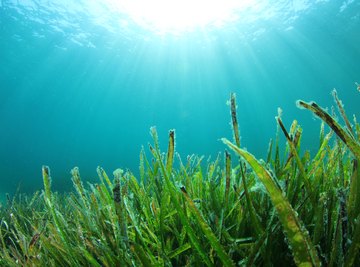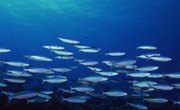
Oceans make up about 70 percent of the Earth's surface. Under these great bodies of water lives a whole other world of plant and animal life that does not exist out of the water. A popular preschool thematic unit is "Under the Sea." While this topic usually focuses on ocean animals, it is important to discuss the plants that live under the sea, too.
Aquarium
Ask parents to send their child to school with an empty shoebox one day. Discard the lid and allow children to paint the box and leave it to dry overnight. Teach children about the types of plants they would typically find in the ocean such as seaweed, kelp, sea grass, algae and coral. Show children pictures of these plants and explain their purpose in the ocean. Provide children with construction paper, scissors and glue sticks to create and cut out the different tyhpes of sea plants they learned about. Attach the sea plants to the back wall of the box aquariums. Allow children to place sand and fish shaped crackers in the aquarium to finish it off. Stretch blue colored plastic wrap over the front of the box aquarium and attach it with tape.
Bulletin Board
Create an "under the sea" bulletin board for displaying messages during your ocean theme week. In addition to including fish and other ocean animals on the bulletin board, ask children which sea plants they would like to include. Provide construction paper and scissors for children to create the types of plants they would find underwater. Have children label the plants so all visitors can learn about underwater plant life, too.
Painting
Fingerpainting is an activity that can easily be used to represent the plant life growing on the ocean floor, and is especially appropriate for preschoolers. This activity can help children learn to work cooperatively as it is a large group or small group project. Provide a long piece of butcher paper to children and ask them to work together to paint the whole thing blue. Allow the paper to dry overnight. The next day, ask children to use their fingers to create the type of plants they would find in the ocean. They can use their fingers to create sea grass or a handprint to represent kelp or algae. You can also provide sponges for painting. Allow children to experiment and find the best way to paint to represent each of the plants you have learned about in class.
Classification
Classification activities boost children's knowledge of scientific principles and pre-math skills. Before children arrive for the day, find and cut out pictures of plants that live in the ocean as well as plants that do not grow underwater. Create a large posterboard with two sections, labelled "In the Ocean" and "NOT In the Ocean." As a large group activity, show the pictures to children one at a time. Ask the children as a group to decide if the picture they see is an ocean-dwelling plant or a land-dwelling plant. Place the pictures in the correct column of the poster and allow children to attach them using a glue stick. Display the poster in your classroom science center.
References
- "Creative Activities for Young Children"; Mary Mayesky; 1995
- National Geographic: Oceans
Resources
About the Author
Kara Bietz has been writing professionally since 1999. Her professional observation work has appeared in the early childhood education textbook "The Art of Awareness" by Margie Carter and Deb Curtis. Bietz has worked in the field of early childhood education for more than 16 years. She holds an Associate of Applied Science in child development from Mesa College.
